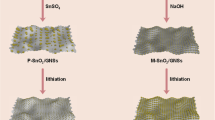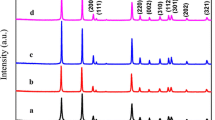Abstract
We demonstrate a facile synthesis of ultrafine SnO2 nanoparticles within graphene nanosheets (GNSs) via thermal decomposition of tin-octoate, in which tin-octoate is firstly blended with GNSs followed by annealing in air at a low temperature (350 °C) and a short time (1 h). As anode for lithium ion batteries, the SnO2/GNSs displays superior cycle and rate performance, delivering reversible capacities of 803 and 682 mA h/g at current densities of 200 and 500 mA/g after 120 cycles, respectively, much higher than that of pure SnO2 and GNSs counterparts (143 and 310 mA h/g at 500 mA/g after 120 cycles, respectively). The enhanced electrochemical performance is attributed to the ultrafine SnO2 nanoparticle size and introduction of GNSs. GNSs prevent the aggregation of the ultrafine SnO2 nanoparticles, which alleviate the stress and also provide more electrochemically active sites for lithium insertion and extraction. Moreover, GNSs with large specific surface area (~363 m2/g) act as a good electrical conductor which greatly improves the electrode conductivity and also an excellent buffer matrix to tolerate the severe volume changes originated from the Li-Sn alloying-dealloying. This work provides a straight-forward synthetic approach for the design of novel composite anode materials with superior electrochemical performance.




Similar content being viewed by others
References
Armstrong MJ, O’Dwyer C, Macklin WJ, Holmes JD (2014) Evaluating the performance of nanostructured materials as lithium-ion battery electrodes. Nano Res 7:1–62. doi:10.1007/s12274-013-0375-x
Cai D et al (2014) A nanocomposite of tin dioxide octahedral nanocrystals exposed to high-energy facets anchored onto graphene sheets for high performance lithium-ion batteries. J Mater Chem A 2:13990. doi:10.1039/c4ta01850h
Cai D et al (2015) Tin dioxide dodecahedral nanocrystals anchored on graphene sheets with enhanced electrochemical performance for lithium-ion batteries. Electrochim Acta 159:46–51. doi:10.1016/j.electacta.2015.01.090
Chan CK, Peng HL, Liu G, McIlwrath K, Zhang XF, Huggins RA, Cui Y (2008) High-performance lithium battery anodes using silicon nanowires. Nat Nanotechnol 3:31–35. doi:10.1038/nnano.2007.411
Chen JS, Lou XW (2013) SnO2-based nanomaterials: synthesis and application in lithium-ion batteries. Small 9:1877–1893. doi:10.1002/smll.201202601
Demir-Cakan R, Hu Y-S, Antonietti M, Maier J, Titirici M-M (2008) Facile one-pot synthesis of mesoporous SnO2 microspheres via nanoparticles assembly and lithium storage properties. Chem Mater 20:1227–1229. doi:10.1021/cm7031288
Deng D, Lee JY (2008) Hollow core-shell mesospheres of crystalline SnO2 nanoparticle aggregates for high capacity Li+ ion storage. Chem Mater 20:1841–1846. doi:10.1021/cm7030575
Ding S, Luan D, Boey FY, Chen JS, Lou XW (2011) SnO2 nanosheets grown on graphene sheets with enhanced lithium storage properties. Chem Commun 47:7155–7157. doi:10.1039/c1cc11968k
Idota Y, Kubota T, Matsufuji A, Maekawa Y, Miyasaka T (1997) Tin-based amorphous oxide: a high-capacity lithium-ion-storage. Mater Sci 276:1395–1397. doi:10.1126/science.276.5317.1395
Jin Y-H, Min K-M, Seo S-D, Shim H-W, Kim D-W (2011) Enhanced Li storage capacity in 3 nm diameter SnO2 nanocrystals firmly anchored on multiwalled carbon nanotubes. J Phys Chem C 115:22062–22067. doi:10.1021/jp208021w
Larese C, Campos-Martin JM, Fierro JLG (2000) Alumina- and zirconia−alumina-loaded tin−platinum. Surface features and performance for butane dehydrogenation. Langmuir 16:10294–10300. doi:10.1021/la0009644
Li Y, Lu X, Wang H, Xie C, Yang G, Niu C (2015) Growth of ultrafine SnO2 nanoparticles within multiwall carbon nanotube networks: non-solution synthesis and excellent electrochemical properties as anodes for lithium ion batteries. Electrochim Acta 178:778–785. doi:10.1016/j.electacta.2015.08.078
Liu J, Li W, Manthiram A (2010) Dense core-shell structured SnO2/C composites as high performance anodes for lithium ion batteries. Chem Commun 46:1437–1439. doi:10.1039/b918501a
Liu X-M, Huang ZD, Oh SW, Zhang B, Ma P-C, Yuen MMF, Kim J-K (2012) Carbon nanotube (CNT)-based composites as electrode material for rechargeable Li-ion batteries: a review. Compos Sci Technol 72:121–144. doi:10.1016/j.compscitech.2011.11.019
Liu X, Cheng J, Li W, Zhong X, Yang Z, Gu L, Yu Y (2014) Superior lithium storage in a 3D macroporous graphene framework/SnO2 nanocomposite. Nanoscale 6:7817–7822. doi:10.1039/c4nr01493f
Liu L, An M, Yang P, Zhang J (2015) Superior cycle performance and high reversible capacity of SnO2/graphene composite as an anode material for lithium-ion batteries. Sci Rep 5:9055. doi:10.1038/srep09055
Lou XW, Wang Y, Yuan C, Lee JY, Archer LA (2006) Template-free synthesis of SnO2 hollow nanostructures with high lithium storage capacity. Adv Mater 18:2325–2329. doi:10.1002/adma.200600733
Lu X, Wang H, Wang Z, Jiang Y, Cao D, Yang G (2016) Room-temperature synthesis of colloidal SnO2 quantum dot solution and ex situ deposition on carbon nanotubes as anode materials for lithium ion batteries. J Alloys Compd 680:109–115. doi:10.1016/j.jallcom.2016.04.128
Nazar LF, Goward G, Leroux F, Duncan M, Huang H, Kerr T, Gaubicher J (2001) Nanostructured materials for energy storage International. J Inorg Mater 3:191–200. doi:10.1016/s1466-6049(01)00026-5
Park S-K et al (2012) A facile hydrazine-assisted hydrothermal method for the deposition of monodisperse SnO2 nanoparticles onto graphene for lithium ion batteries. J Mater Chem 22:2520–2525. doi:10.1039/c1jm14199f
Potts JR, Murali S, Zhu Y, Zhao X, Ruoff RS (2011) Microwave-exfoliated graphite oxide/polycarbonate composites. Macromolecules 44:6488–6495. doi:10.1021/ma2007317
Sangjin H, Byungchul J, Taeahn K, Oh SM, Taeghwan H (2005) Simple synthesis of hollow tin dioxide microspheres and their application to lithium-ion battery anodes. Adv Funct Mater 15:1845–1850. doi:10.1002/adfm.200500243
Stankovich S et al (2006) Graphene-based composite materials. Nature 442:282–286. doi:10.1038/nature04969
Tarascon JM, Armand M (2001) Issues and challenges facing rechargeable lithium batteries. Nature 414:359–367
Wang H, Rogach AL (2014) Hierarchical SnO2 nanostructures: recent advances in design, synthesis, and applications. Chem Mater 26:123–133. doi:10.1021/cm4018248
Wang Y, Zeng HC, Lee JY (2006) Highly reversible lithium storage in porous SnO2 nanotubes with coaxially grown carbon nanotube overlayers. Adv Mater 18:645–649. doi:10.1002/adma.200501883
Wang C, Zhou Y, Ge M, Xu X, Zhang Z, Jiang JZ (2010) Large-scale synthesis of SnO2 nanosheets with high lithium storage capacity. J Am Chem Soc 132:46–47. doi:10.1021/ja909321d
Wang Z, Luan D, Boey FYC, Lou XW (2011) Fast formation of SnO2 nanoboxes with enhanced lithium storage capability. J Am Chem Soc 133:4738–4741. doi:10.1021/ja2004329
Wang H et al (2012) Hydrothermal synthesis of hierarchical SnO2 microspheres for gas sensing and lithium-ion batteries applications: fluoride-mediated formation of solid and hollow structures. J Mater Chem 22:2140–2148. doi:10.1039/c1jm14839g
Wang H et al (2013a) Hierarchical assembly of Ti(IV)/Sn(II) co-doped SnO2 nanosheets along sacrificial titanate nanowires: synthesis, characterization and electrochemical properties. Nanoscale 5:9101–9109. doi:10.1039/c3nr02456c
Wang X, Li Z, Yin L (2013b) Nanocomposites of SnO2@ordered mesoporous carbon (OMC) as anode materials for lithium-ion batteries with improved electrochemical performance. CrystEngComm 15:7589–7597. doi:10.1039/c3ce41256c
Wang H, Kalytchuk S, Yang H, He L, Hu C, Teoh WY, Rogach AL (2014a) Hierarchical growth of SnO2 nanostructured films on FTO substrates: structural defects induced by Sn(ii) self-doping and their effects on optical and photoelectrochemical properties. Nanoscale 6:6084–6091. doi:10.1039/C4NR00672K
Wang H et al (2014b) Synthesis and characterization of tin titanate nanotubes: precursors for nanoparticulate Sn-doped TiO2 anodes with synergistically improved electrochemical performance. ChemElectroChem 1:1563–1569. doi:10.1002/celc.201402188
Wang H et al (2016) Synthesis of SnO2 versus Sn crystals within N-doped porous carbon nanofibers via electrospinning towards high-performance lithium ion batteries. Nanoscale 8:7595–7603. doi:10.1039/C5NR09305H
Xu C, Sun J, Gao L (2012) Direct growth of monodisperse SnO2 nanorods on graphene as high capacity anode materials for lithium ion batteries. J Mater Chem 22:975–979. doi:10.1039/c1jm14099j
Yang Y, Ji X, Lu F, Chen Q, Banks CE (2013) The mechanistic exploration of porous activated graphene sheets-anchored SnO2 nanocrystals for application in high-performance Li-ion battery anodes. Phys Chem Chem Phys 15:15098–15105. doi:10.1039/c3cp52808a
Yin XM, Li CC, Zhang M, Hao QY, Liu S, Chen LB, Wang TH (2010) One-step synthesis of hierarchical SnO2 hollow nanostructures via self-assembly for high power lithium ion batteries. J Phys Chem C 114:8084–8088. doi:10.1021/jp100224x
Zhai C, Du N, Zhang H, Yu J, Yang D (2011) Multiwalled carbon nanotubes anchored with SnS2 nanosheets as high-performance anode materials of lithium-ion batteries. ACS Appl Mater Interfaces 3:4067–4074. doi:10.1021/am200933m
Zhang M et al (2011) Fast synthesis of SnO2/graphene composites by reducing graphene oxide with stannous ions. J Mater Chem 21:1673–1676. doi:10.1039/c0jm03410j
Zhang L, Zhang G, Wu HB, Yu L, Lou XW (2013) Hierarchical tubular structures constructed by carbon-coated SnO2 nanoplates for highly reversible lithium storage. Adv Mater 25:2589–2593. doi:10.1002/adma.201300105
Zhou X, Wan L-J, Guo Y-G (2013) Binding SnO2 nanocrystals in nitrogen-doped graphene sheets as anode materials for lithium-ion batteries. Adv Mater 25:2152–2157. doi:10.1002/adma.201300071
Zhu Y, Murali S, Stoller MD, Velamakanni A, Piner RD, Ruoff RS (2010) Microwave assisted exfoliation and reduction of graphite oxide for ultracapacitors. Carbon 48:2118–2122. doi:10.1016/j.carbon.2010.02.001
Acknowledgments
This work was supported by the National Science Foundation of China (Grant No. 51402232 and 51521065), the Fundamental Research Funds for the Central Universities in China, the Natural Science Basis Research Plan in Shaanxi Province of China (Grant No. 2015JQ5131) and the Open Fund of the State Key Laboratory of Luminescent Materials and Devices (South China University of Technology, Grant No. 2016-skllmd-04). The authors also thank Ms. Yazhu Dai and Mr. Chuansheng Ma for their help with SEM/TEM measurements, carried out at International Center for Dielectric Research (ICDR), Xi’an Jiaotong University, Xi’an, China.
Author information
Authors and Affiliations
Corresponding authors
Electronic supplementary material
Below is the link to the electronic supplementary material.
Rights and permissions
About this article
Cite this article
Wang, J., Xie, S., Cao, D. et al. Facile synthesis of ultrafine SnO2 nanoparticles on graphene nanosheets via thermal decomposition of tin-octoate as anode for lithium ion batteries. J Nanopart Res 18, 280 (2016). https://doi.org/10.1007/s11051-016-3590-z
Received:
Accepted:
Published:
DOI: https://doi.org/10.1007/s11051-016-3590-z




